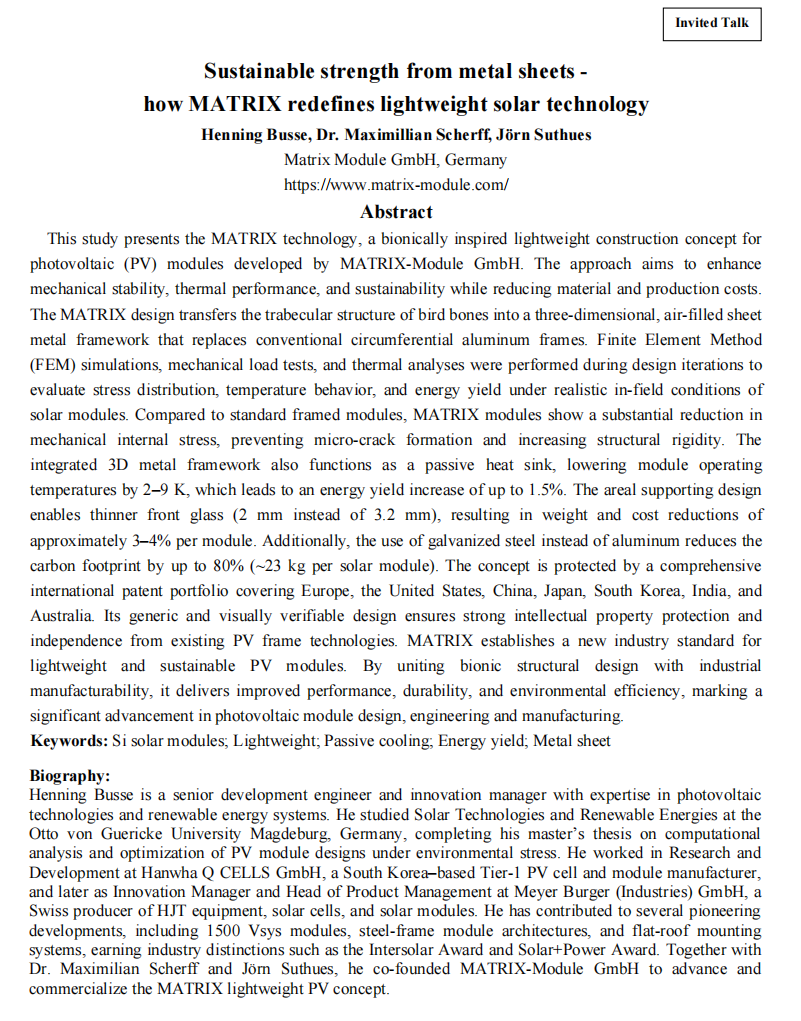| Sustainable strength from metal sheets - how MATRIX redefines lightweight solar technology【Henning Busse】 |
| 发布时间:2025-10-20 | 浏览次数:119 |
Sustainable strength from metal sheets - how MATRIX redefines lightweight solar technology Henning Busse, Dr. Maximillian Scherff, Jörn Suthues Matrix Module GmbH, Germany https://www.matrix-module.com Abstract This study presents the MATRIX technology, a bionically inspired lightweight construction concept for photovoltaic (PV) modules developed by MATRIX-Module GmbH. The approach aims to enhance mechanical stability, thermal performance, and sustainability while reducing material and production costs. The MATRIX design transfers the trabecular structure of bird bones into a three-dimensional, air-filled sheet metal framework that replaces conventional circumferential aluminum frames. Finite Element Method (FEM) simulations, mechanical load tests, and thermal analyses were performed during design iterations to evaluate stress distribution, temperature behavior, and energy yield under realistic in-field conditions of solar modules. Compared to standard framed modules, MATRIX modules show a substantial reduction in mechanical internal stress, preventing micro-crack formation and increasing structural rigidity. The integrated 3D metal framework also functions as a passive heat sink, lowering module operating temperatures by 2–9 K, which leads to an energy yield increase of up to 1.5%. The areal supporting design enables thinner front glass (2 mm instead of 3.2 mm), resulting in weight and cost reductions of approximately 3–4% per module. Additionally, the use of galvanized steel instead of aluminum reduces the carbon footprint by up to 80% (~23 kg per solar module). The concept is protected by a comprehensive international patent portfolio covering Europe, the United States, China, Japan, South Korea, India, and Australia. Its generic and visually verifiable design ensures strong intellectual property protection and independence from existing PV frame technologies. MATRIX establishes a new industry standard for lightweight and sustainable PV modules. By uniting bionic structural design with industrial manufacturability, it delivers improved performance, durability, and environmental efficiency, marking a significant advancement in photovoltaic module design, engineering and manufacturing. Keywords: Si solar modules; Lightweight; Passive cooling; Energy yield; Metal sheet Biography: Henning Busse is a senior development engineer and innovation manager with expertise in photovoltaic technologies and renewable energy systems. He studied Solar Technologies and Renewable Energies at the Otto von Guericke University Magdeburg, Germany, completing his master’s thesis on computational analysis and optimization of PV module designs under environmental stress. He worked in Research and Development at Hanwha Q CELLS GmbH, a South Korea–based Tier-1 PV cell and module manufacturer, and later as Innovation Manager and Head of Product Management at Meyer Burger (Industries) GmbH, a Swiss producer of HJT equipment, solar cells, and solar modules. He has contributed to several pioneering developments, including 1500 Vsys modules, steel-frame module architectures, and flat-roof mounting systems, earning industry distinctions such as the Intersolar Award and Solar+Power Award. Together with Dr. Maximilian Scherff and Jörn Suthues, he co-founded MATRIX-Module GmbH to advance and commercialize the MATRIX lightweight PV concept.
|






